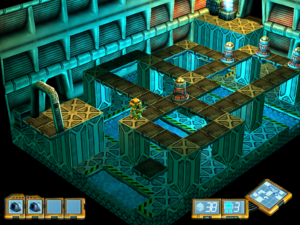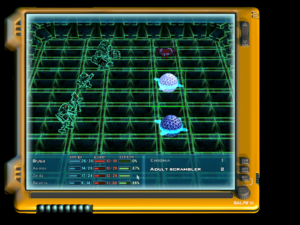Mr. Robot
Here’s a hard one to classify: it’s a combination of a 3D platformer, with realtime enemy-dodging and Sokoban-like block-pushing elements, and a combat-based RPG. Platformer-mode and RPG-mode are basically separate, with completely different control systems and graphical styles, and don’t have very great effect on each other except on the level of plot. I suppose that a lot of CRPGs (particularly the old ones) have separate style and mechanics for the overland exploration mode and the dungeons or whatever, but here, Platformer-mode could have been a satisfying game in its own right.
 The premise is that you’re a general-purpose worker robot on an interstellar colony ship. You can probably guess the initial plot complications: something goes wrong, the colonists aren’t brought out of cryo-sleep, the ship’s main AI seems to have gone mad. (Just in case you might not be expecting this from the start, the authors have named the ship’s AI “HEL 9000”, just one letter off from a 2001 reference. It’s blatant enough to make me wonder if they’re planning on subverting it in a later chapter.) The ship is made of rooms, which are made of tiles, which are viewed from a fixed oblique angle. I almost described it as “isometric perspective”, but inspection of apparent sizes of tiles proves that wrong: it’s just ordinary linear perspective viewed from an unusual vantage point. I suppose it’s easier to do it that way in the age of ubiquitous 3D graphics support. Still, it plays like an isometric platformer, which is to say, it’s sometimes hard to tell where things are spatially, and it takes a while to get used to how the controls work with the diagonal grid lines.
The premise is that you’re a general-purpose worker robot on an interstellar colony ship. You can probably guess the initial plot complications: something goes wrong, the colonists aren’t brought out of cryo-sleep, the ship’s main AI seems to have gone mad. (Just in case you might not be expecting this from the start, the authors have named the ship’s AI “HEL 9000”, just one letter off from a 2001 reference. It’s blatant enough to make me wonder if they’re planning on subverting it in a later chapter.) The ship is made of rooms, which are made of tiles, which are viewed from a fixed oblique angle. I almost described it as “isometric perspective”, but inspection of apparent sizes of tiles proves that wrong: it’s just ordinary linear perspective viewed from an unusual vantage point. I suppose it’s easier to do it that way in the age of ubiquitous 3D graphics support. Still, it plays like an isometric platformer, which is to say, it’s sometimes hard to tell where things are spatially, and it takes a while to get used to how the controls work with the diagonal grid lines.
 Every once in a while there’s an obstacle that can’t be jumped over or pushed aside, and instead has to be hacked around. Cyberspace is where the RPG stuff comes in: you hack by defeating various software entities in turn-based combat. Cyberspace combat may seem dauntingly complex at first, with lots of unfamiliar concepts to learn, but only until you notice that it’s really just standard fantasy combat with the words changed: “I.C.E.” is weapons, “programs” are spells, “extreme attacks” are limit breaks, etc. There are some interesting character types, such as the “Comms Mech”, which seems to specialize in manipulating “power” (mana): stealing it from enemies, sharing it with friends.
Every once in a while there’s an obstacle that can’t be jumped over or pushed aside, and instead has to be hacked around. Cyberspace is where the RPG stuff comes in: you hack by defeating various software entities in turn-based combat. Cyberspace combat may seem dauntingly complex at first, with lots of unfamiliar concepts to learn, but only until you notice that it’s really just standard fantasy combat with the words changed: “I.C.E.” is weapons, “programs” are spells, “extreme attacks” are limit breaks, etc. There are some interesting character types, such as the “Comms Mech”, which seems to specialize in manipulating “power” (mana): stealing it from enemies, sharing it with friends.
About those friends: Yes, cyberspace is party-based, even though there’s only one of you in Platformer mode. The rest of your party isn’t physically present: it’s the “ghosts” of robot minds that you’ve stored in your own memory, rescuing them when their physical bodies are destroyed. You know how in some RPGs only the leader of your party is visible on the overland map? I think Mr. Robot is the first game I’ve seen that has a reasonable reason for that.
Anyway, just as there are lots of RPGs with a separate overland mode, there are lots of sci-fi games (including some platformers) that have some kind of hacking mini-game. But here, even though the hacking fills a mini-game’s niche in the platformer, it doesn’t feel like one. It’s too elaborate for that, too large a part of the total game experience, and, perhaps most of all, the persistence of state (experience, equipment, and so forth) between hacking sessions seems very non-mini-game-like. Like the platforming part, it could be a full game in its own right. So do the two aspects of Mr. Robot gain anything from being conjoined like this? Well, at the very least, it provides some variety of action. I’ve already put in a couple of multi-hour sessions today, and I can easily imagine either mode becoming tedious if unrelieved.
 Comments(0)
Comments(0)